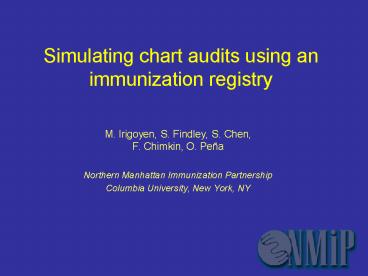Simulating chart audits using an immunization registry - PowerPoint PPT Presentation
Title:
Simulating chart audits using an immunization registry
Description:
CDC funded demonstration project in Northern Manhattan, New York City. Conducted semi-annual CASA audits at 23 practices in Northern Manhattan ... – PowerPoint PPT presentation
Number of Views:22
Avg rating:3.0/5.0
Title: Simulating chart audits using an immunization registry
1
Simulating chart audits using an immunization
registry
- M. Irigoyen, S. Findley, S. Chen,F. Chimkin, O.
Peña - Northern Manhattan Immunization Partnership
- Columbia University, New York, NY
2
Background
- Chart audits are the gold standard for assessing
practice immunization coverage but they are time
and labor intensive - Immunization registries offer the potential for
reliable and timely practice assessment
3
Objective
- To simulate practice immunization chart audits
using an immunization registry - To compare registry-based coverage rates assessed
by two methods universal assessment and random
sample
4
Northern Manhattan Immunization Partnership (NMIP)
- CDC funded demonstration project in Northern
Manhattan, New York City - Conducted semi-annual CASA audits at 23 practices
in Northern Manhattan - Developed a regional registry to facilitate
sharing of records among practices and expedite
upload to city immunization registry
5
EzVAC Immunization Registry
- Established by NMIP to serve the community of
Northern Manhattan - Web-based and real time
- Launched March 1999
- Currently at 30 practices
- 120,000 children in the registry
- Regular uploads and downloads to NY Citywide
Immunization Registry
6
EzVAC Registry
EzVAC Registry
School Based Clinics
New York Presbyterian Hospital Ambulatory Care
Network
Community Providers
NYC DOH Citywide Immunization Registry
7
Sites Participating in the Audit Simulation
- 5 hospital-affiliated practices in Northern
Manhattan, NYC - Study population Latino, Low-income children,
85 Medicaid - Assessments Oct 01 and April 02, 2 years after
registry launch - Registry immunization capture rate 98
8
Comparison of Practice Coverage Assessments All
cases versus Sample of cases
- Universal Assessment Advantage that all eligible
children with records in the registry are
included, but can be time consuming - Random sample following Chart Audit (CASA)
procedures Includes only a random sample of
children, minimizing run times
9
Criteria for Including Children in the Assessment
Study
- Children ages 6 - 35 months at time of audit
(October 2001 and April 2002) - One or more visits to the practice
- At least one immunization record in the registry
10
Immunization Outcome
- DTaPPolioMMRHibHepB (43133) age
-appropriate immunization coverage rate - Practice coverage of children with
age-appropriate immunizations, as of the date of
the assessment
11
Steps in the Universal Assessment
- Queried registry for eligible children in each of
5 practices (n 16,021) - Calculated proportion of children with
age-appropriate immunizations for 3 age groups
6-11m, 12-23m 24-35m - Practice assessments prepared for October 2001
and April 2002 by age group and practice site
12
Steps in Random Sampling Assessment
- Used same registry queries to prepare lists of
eligible children by age group, in each of 5
practices - Sampling proportional to size of each age group,
with sampling fraction calculated to yield 345
children (300 15 margin) per practice
13
Steps in Random Sampling Assessment
- Used SPPS random selection procedure to generate
list of children - Practice assessments prepared for October 2001
and April 2002 by age group and practice site
14
Case Sampling From 5 Practices (April 2002)
15
Comparison of Coverage Rates (6-11 month-olds)
T tests show no significant differences by type
of assessment
16
Comparison of Coverage Rates (12-23 month-olds)
T tests show no significant differences by type
of assessment
17
Comparison of Coverage Rates (24-35 month-olds)
T tests show no significant differences by type
of assessment
18
Conclusion
- When using immunization registries for practice
coverage assessments, random sampling using CASA
methodologies yield equivalent results to
universal evaluation
19
Implications
- When there are time considerations, e.g. run
time, the random sample assessment methodology
can be used to generate practice assessments - This methodology could be applied to generate
HEDIS reports and city or state-wide assessments.































